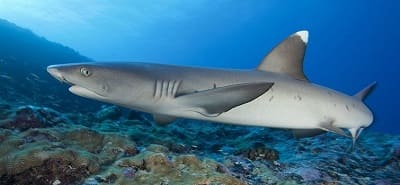Home › Sea Life › Marine › Vertebrates › Sharks › White Tips
Facts about Whitetip Reef Sharks
[Phylum: Chordata] [Class: Chondrichthyes] [Order: Carcharhiniformes] [Family: Carcharhinidae]
It's fair to say that the most distinguishing characteristic of the genus called Triaenodon obesus is the slender body capped with a white-tipped dorsal and caudal fin.
This guide contains fun and interesting facts about white tip reef sharks, including where they still exist, what they eat, and how they reproduce.
Triaenodon Obesus Habitat and Distribution
Having a slim body means this particular species of requiem shark can manoeuvre its way through tight spaces.
Scuba divers will most likely see them prowling around select coral reef habitats of the Indo-Pacific region.
Here's the thing:
You may see big white tips resting on the open seabed. But, the small ones tend to seek refuge underneath overhangs, ledges, inside caves, or hiding around coral outcrops.
In general, reef-building coral polyps grow faster in shallow water that receives lots of sunlight. As a result, the favourite stomping ground for a white tip reef shark tends to be shallower than forty (40) metres (131 feet).
In fact, requiem sharks will also hunt for prey in clear, shallow water close to the beach - even less than one metre deep.
Yet, there is also documented evidence of them being captured at depths approaching 330 metres (182 feet), near the Ryukyu Islands of Japan.
Pro Tip: For the most part, the whitetip reef shark species will spend most of its life at depths between eight (8) and forty (40) metres. Hence, Open Water divers should expect to encounter their presence in some of the best diving destinations around the world.
White Tips Behaviour and Characteristics
One of the lesser known and most interesting traits about whitetip reef sharks is their habit of 'nesting'. Thus, they stay in small zones, often clustering together in groups, hanging out as a community in a single area of less than a square kilometre.
Furthermore, it's not uncommon for this particular shark species to return to the exact same lair. Sometimes, they will keep returning for several weeks, months, or even longer.
Which leads us to...
A defining characteristic of requiem sharks is that they need to swim forward with its mouth open to breathe. Even so, whitetip reef sharks have developed a mechanism that pumps water over the gills.
Because they don't use 'ram ventilation', they display a rare social behaviour for sharks and often stack up on top of one another - appearing as a pile of greyish, motionless tree trunks.
Fun fact:
So, you must be wondering... how big is a whitetip reef shark? In fact, at full maturity an adult Triaenodon obesus will grow to an average length of about one and a half metres (5.3 feet).
However, the maximum length for a white tip is 2.1 metres (7 feet) and the heaviest recorded was 18.3 kilograms (40.3 pounds).
What Do Whitetip Reef Sharks Eat?
Because they are nocturnal predators, they wait for the darkness to fall before they start hunting for food. As they become active, they use electroreceptors to seek out weak or vulnerable bottom-dwelling prey, such as:
- Bony reef fishes
 Crabs
Crabs- Crustaceans
- Moray eels
- Octopuses
- Parrotfishes
- Snappers
- Spiny lobsters
- Triggerfish
Often, white tip sharks will chase their prey into a small cave or narrow crevice as a hunting methodology. Having trapped the animal, they will jam their lean and slim body to block an escape and then use their snout to snare it before eating it.
How Do Whitetip Sharks Reproduce?
In fact, whitetip reef sharks will not reach sexual maturity until they are at least eight (8) years of age. Plus, they use internal fertilisation to mate, meaning the male will fertilise the egg inside the female. In most cases, females will give birth to at least one, but no more than five, pups per litter.
Threats and Natural Predators
Despite their formidable hunting skills, several species of larger fish prey upon whitetip reef sharks, including giant groupers and tiger sharks (Galeocerdo cuvier).
In the wild, it is common for white tips to live for at least twenty five (25) years. But, human behaviour has made their future survival somewhat uncertain.
Why?
The use of line and trawl nets (e.g. in the commercial fishing industry) has diminished what was once an abundant population.
As a result, overfishing in some shallow water habitats means whitetip reef sharks, along with many other species of shark, die as bycatch in gillnets. Other detrimental factors include:
- Late maturity age
- Loss of coral reef habitats
- Small litter size
Important: According to the IUCN Red List of Threatened Species, a recent assessment for the whitetip reef shark (Triaenodon obesus) lists the species as "vulnerable". Despite this, many shark conservation groups consider their survival as being "threatened with extinction".
Related Information and Help Guides
- Angel Shark Fun Facts and Information (Squatina Squatina)
- Bull Shark Reproduction and Life Cycle
- Baby Sharks Released in Thailand
- Fun and Interesting Facts about Hammerheads (Sphyrnidae)
- Horn Shark (Heterodontus Francisci) Fun Facts and Information
- Leopard Shark Behaviour and Characteristics
- Nurse Shark Interesting Facts and Information with Pictures
Note: The short video [2:11 seconds] presented by Deep Marine Scenes contains interesting footage about the whitetip reef shark, a small non aggressive requiem shark that spends most of the time resting on the seafloor.